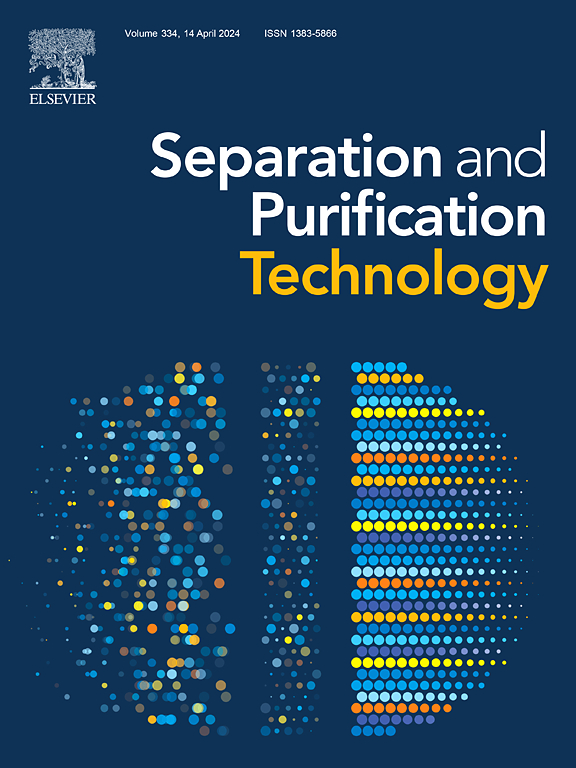聚苯胺修饰CNT/CS碳气凝胶复合电极的制备及其对铀的电吸附性能
IF 8.1
1区 工程技术
Q1 ENGINEERING, CHEMICAL
引用次数: 0
摘要
电吸附技术以其能耗低、环境友好、易于再生等优点在U(VI)回收领域备受关注。然而,它的应用仍然受到一些挑战的限制,包括电极材料中活性位点不足、表面润湿性差以及固有的离子排斥效应。本研究将碳纳米管掺入壳聚糖溶液中,成功制备了碳气凝胶。通过电沉积不同浓度的聚苯胺,制备了一种新型碳纳米管/壳聚糖/聚苯胺复合电极。CCP电极具有稳定的三维多孔结构、高比电容、优异的亲水性和出色的充放电稳定性。实验结果表明,U(VI)在CCP电极上的电吸附行为受外加电压和溶液ph的影响,动力学过程符合拟一阶模型,吸附等温线符合Langmuir模型。在最佳条件下(0.9 V, pH 4.5), CCP-2电极的最大U(VI)电吸附量为344.8 mg/g。系统的充放电循环测试表明,经过7次循环后,CCP-2电极的吸附容量保持在85% %以上,具有良好的循环稳定性。进一步研究发现,CCP-2电极出色的U(VI)电吸附性能源于双电层电容和赝电容的协同作用。此外,电极表面丰富的NH、NH+和OH官能团提供了大量的活性位点。这些基团之间的相互作用和协同作用显著增强了铀的吸附能力。本研究为高效脱除含铀废水中的铀(VI)提供了一种新的解决方案。本文章由计算机程序翻译,如有差异,请以英文原文为准。
Fabrication of polyaniline-modified CNT/CS carbon aerogel composite electrode and its electrosorption performance of uranium
Electrosorption technology has garnered significant attention in the field of U(VI) recovery due to its advantages such as low energy consumption, environmental friendliness, and easy regeneration. However, its application remains limited by challenges including insufficient active sites in electrode materials, poor surface wettability, and inherent ion rejection effects. In this study, carbon nanotubes were incorporated into a chitosan solution to successfully prepare carbon aerogel. By electrodepositing polyaniline at different concentrations, a novel carbon nanotube/chitosan/polyaniline composite electrode (CCP) was developed. The CCP electrode exhibits a stable three-dimensional porous structure, high specific capacitance, excellent hydrophilicity, and outstanding charge–discharge stability. The experimental results demonstrate that the electrosorption behavior of U(VI) on the CCP electrode is influenced by both applied voltage and solution pH. The kinetic process follows the pseudo-first-order model, while the adsorption isotherm conforms to the Langmuir model. Under optimal conditions (0.9 V, pH 4.5), the CCP-2 electrode achieves a maximum U(VI) electrosorption capacity of 344.8 mg/g. Systematic charge–discharge cycling tests demonstrated that the CCP-2 electrode maintained over 85 % of its adsorption capacity after 7 cycles, exhibiting excellent cycling stability. Further investigation revealed that the outstanding U(VI) electrosorption performance of CCP-2 electrode originated from the synergistic effects of electric double-layer capacitance and pseudocapacitance. Moreover, the abundant  NH
NH ,
,  NH+
NH+ and
and  OH functional groups on the electrode surface provided numerous active sites. The interactions and synergistic effects among these groups significantly enhanced the uranium adsorption capacity. This study provides a novel solution for efficient U(VI) removal from uranium-containing wastewater.
OH functional groups on the electrode surface provided numerous active sites. The interactions and synergistic effects among these groups significantly enhanced the uranium adsorption capacity. This study provides a novel solution for efficient U(VI) removal from uranium-containing wastewater.
 NH
NH ,
,  NH+
NH+ and
and  OH functional groups on the electrode surface provided numerous active sites. The interactions and synergistic effects among these groups significantly enhanced the uranium adsorption capacity. This study provides a novel solution for efficient U(VI) removal from uranium-containing wastewater.
OH functional groups on the electrode surface provided numerous active sites. The interactions and synergistic effects among these groups significantly enhanced the uranium adsorption capacity. This study provides a novel solution for efficient U(VI) removal from uranium-containing wastewater.
求助全文
通过发布文献求助,成功后即可免费获取论文全文。
去求助
来源期刊

Separation and Purification Technology
工程技术-工程:化工
CiteScore
14.00
自引率
12.80%
发文量
2347
审稿时长
43 days
期刊介绍:
Separation and Purification Technology is a premier journal committed to sharing innovative methods for separation and purification in chemical and environmental engineering, encompassing both homogeneous solutions and heterogeneous mixtures. Our scope includes the separation and/or purification of liquids, vapors, and gases, as well as carbon capture and separation techniques. However, it's important to note that methods solely intended for analytical purposes are not within the scope of the journal. Additionally, disciplines such as soil science, polymer science, and metallurgy fall outside the purview of Separation and Purification Technology. Join us in advancing the field of separation and purification methods for sustainable solutions in chemical and environmental engineering.
 求助内容:
求助内容: 应助结果提醒方式:
应助结果提醒方式:


